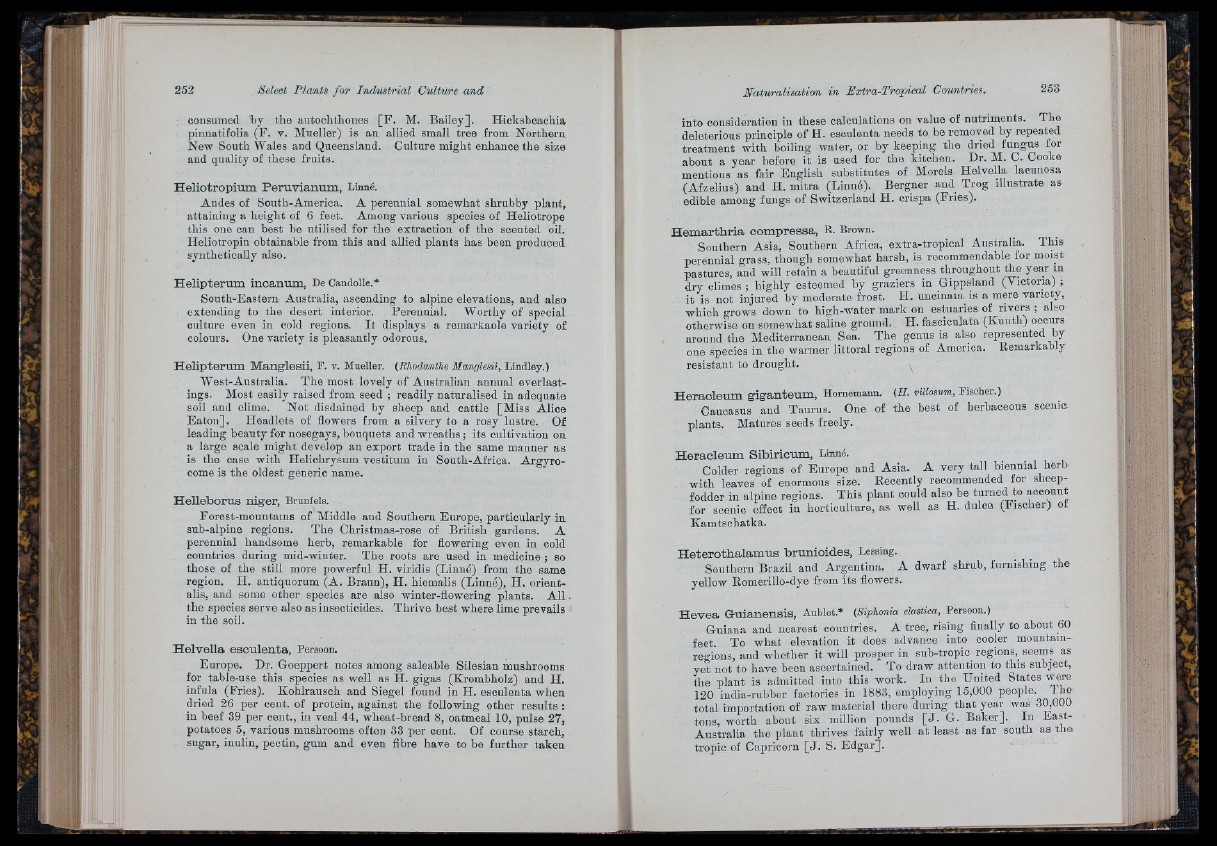
a i
tll:i
262 Select Plants fo r Industrial Culture and
consumed by the autochthones [F . M. Bailey]. H-ieksbeachia
pinnatifolia (F. v. Mueller) is an allied small tree from Northern
New South Wales and Queensland. Culture might enhance the size
and quality of these fruits.
Heliotropium Peruvianum, Linné.
Andes of South-America. A perennial somewhat shrubby plant,
attaining a height of 6 feet. Among various species of Heliotrope
this one can best be utilised for the extraction of the scented oil.
Heliotropin obtainable from this and allied plants has been produced
synthetically also.
Helipterum incanum, De Candolle.*
South-Eastern Australia, ascending to alpine elevations, and also
extending to the desert interior. Perennial. Worthy of special
culture even in cold regions. I t displays a remarkaole variety of
colours. One variety is pleasantly odorous.
Helipterum Manglesii, F. v. Mueller. (Rhodanthe Manglesii, Lindley.)
West-Australia. The most lovely of Australian annual everlastings.
Most easily raised from seed ; readily naturalised in adequate
soil and clime. Not disdained by sheep and cattle [Miss Alice
Ea to n ]. Headlets of flowers from a silvery to a rosy lustre. Of
leading beauty for nosegays, bouquets and wreaths ; its cultivation on
a large scale might develop an export trade in the same manner as
is the case with Helichrysum vestitum iu South-Africa. Argyro-
come is the oldest generic name.
Helleborus niger, Brunfels.
Forest-mountams of Middle and Southern Europe, particularly in
sub-alpine regions. The Christmas-rose of British gardens. A
perennial handsome herb, remarkable for flowering even in cold
countries during mid-winter. The roots are used in medicine ; so
those of the still more powerful H. viridis (Linné) from the same
region. H. antiquorum (A. Braun), H. hiemalis (Linné), H. orientalis,
and some other species are also winter-flowering plants. A ll ■
the species serve also as insecticides. Thrive best where lime prevails
in the soil.
HelveUa esculenta, Persoon.
Europe. Dr. Goeppert notes among saleable Silesian mushrooms
for table-use this species as well as H. gigas (Krombholz) and H.
Ínfula (Fries). Kohlrausoh and Siegel found in H. esculenta when
dried 26 per cent, of protein, against the following other results :
in beef 39 per cent., in veal 44, wheat-bread 8, oatmeal 10, pulse 27,
potatoes 5, various mushrooms often 33 per cent. Of course starch,
sugar, inulin, pectin, gum and even fibre have to be further taken
i
into consideration in these calculations on value of nutriments. The
deleterious principle of H. esculenta needs to be removed by repeated
treatment with boiling water, or by keeping, the dried fungus for
about a year before it is used for the kitchen. Dr. M. C. Cooke
mentions as fair English substitutes of Morels Helvella lacunosa
(Afzelius) and H. mitra (Linné). Bergner and Trog illustrate as-
edible among fungs of Switzerland H. crispa (Fries).
Hemarthria compressa, R. Brown.
Southern Asia, Southern Africa, extra-tropical Australia. This
perennial grass, though somewhat harsh, is reeommendable for moist
pastures, and will retain a beautiful greenness throughout the year in
dry climes ; highly esteemed by graziers in Gippsland (Victoria) ;
it is not injured by moderate frost. II . uncinata is a mere variety,
which grows down to high-water mark on estuaries of rivers ; also
otherwise on somewhat saline ground. H. fasciculata (Kunth) occurs
around the Mediterranean Sea. The genus is also represented by
one species in the warmer littoral regions of America. Remarkably
resistant to drought.
Heracleum giganteum, Hornemann. (H. villosnm, Fischer.)
Caucasus and Taurus. One of the best of herbaceous scenic
plants. Matures seeds freely.
Heracleum Sibiricum, Linné.
Colder regions of Europe and Asia. A very tall biennial herb-
with leaves of enormous size. Recently recommended for sheep-
fodder in alpine regions. This plant could also be turned to account
for scenic eifect in horticulture, as well as H. dulce (Fischer) ot
Kamtschatka.
Heterothalamus brunioides, Lessing.
Southern Brazil and Argentina. A dwarf shrub, furnishing the-
yellow Romerillo-dye from its flowers.
Hevea Guianensis, Aublet.* (SipUnia elastica, Persoon.)
Guiana and nearest countries. A tree, rising finally to about 60
feet. To what elevation it does advance into cooler mountain-
regions, and whether it will prosper in sub-tropic regions,^ seems as
yet not to have been ascertained. To draw attention to this subject,
the plant is admitted into this work. In the United States were
120 india-rubber factories in 1883, employing 15,000 people, ih e
total importation of raw material there during th a t year was 30,000
tons, worth about six million pounds [ J . G. Baker]. In East-
Australia the plant thrives fairly well a t least as far south as th e
tropic of Capricorn [ J . S. Edgar].
i i
’ ¥ , { 1